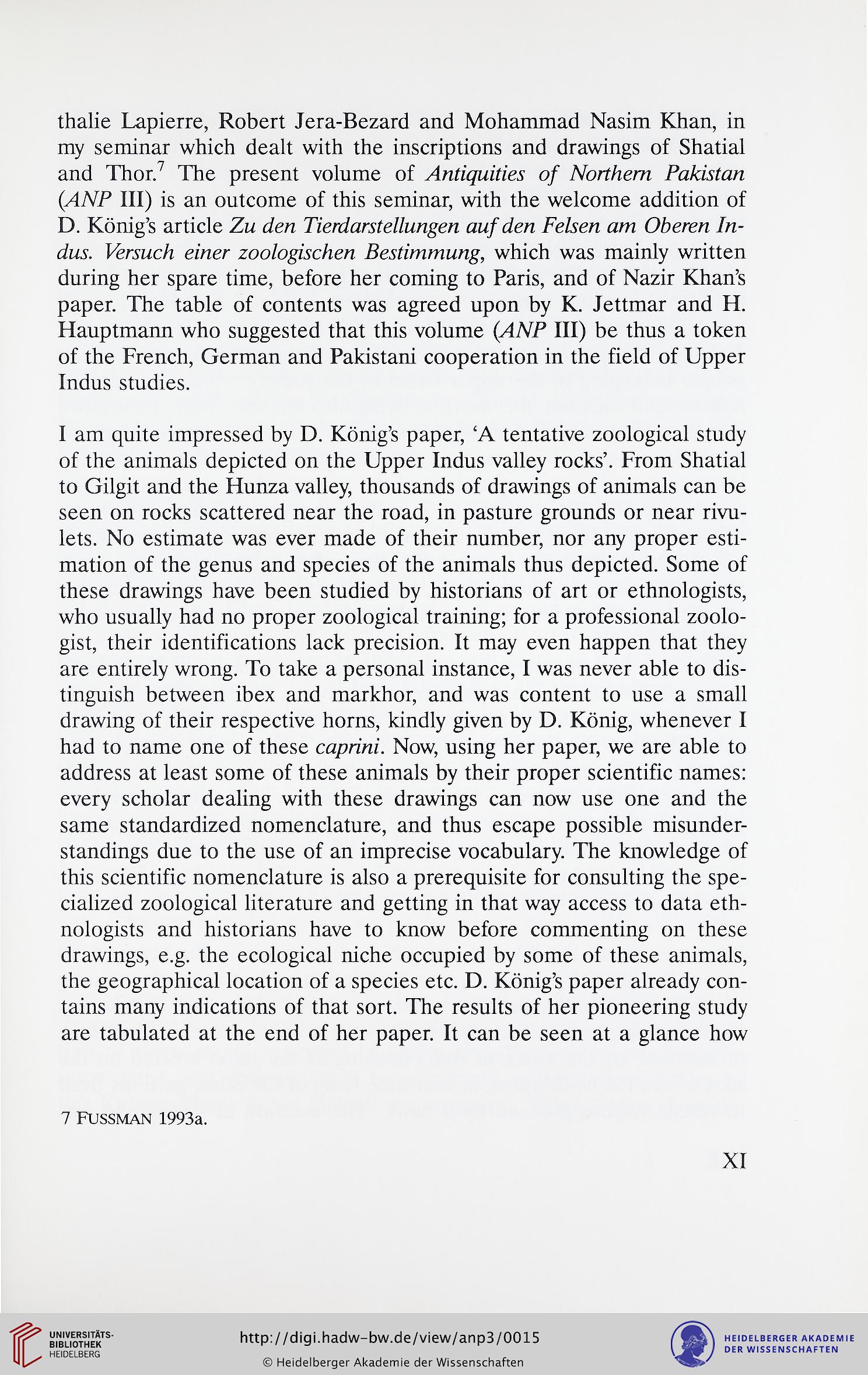thalie Lapierre, Robert Jera-Bezard and Mohammad Nasim Khan, in
my seminar which dealt with the inscriptions and drawings of Shatial
and Thor7 The present volume of A/mi/mYias o/*
(HAP III) is an outcome of this seminar, with the welcome addition of
D. Konig's article Zu zzzv/FcPe/z Oberczz 7n-
Ur.su cA emer zoo/o^c/zeu Pc.stun/uuu^, which was mainly written
during her spare time, before her coming to Paris, and of Nazir Khan's
paper. The table of contents was agreed upon by K. Jettmar and H.
Hauptmann who suggested that this volume (AAP III) be thus a token
of the French, German and Pakistani cooperation in the field of Upper
Indus studies.
I am quite impressed by D. Konig's paper, 'A tentative zoological study
of the animals depicted on the Upper Indus valley rocks'. From Shatial
to Gilgit and the Hunza valley, thousands of drawings of animals can be
seen on rocks scattered near the road, in pasture grounds or near rivu-
lets. No estimate was ever made of their number, nor any proper esti-
mation of the genus and species of the animals thus depicted. Some of
these drawings have been studied by historians of art or ethnologists,
who usually had no proper zoological training; for a professional zoolo-
gist, their identifications lack precision. It may even happen that they
are entirely wrong. To take a personal instance, I was never able to dis-
tinguish between ibex and markhor, and was content to use a small
drawing of their respective horns, kindly given by D. Konig, whenever I
had to name one of these capnm. Now, using her paper, we are able to
address at least some of these animals by their proper scientific names:
every scholar dealing with these drawings can now use one and the
same standardized nomenclature, and thus escape possible misunder-
standings due to the use of an imprecise vocabulary. The knowledge of
this scientific nomenclature is also a prerequisite for consulting the spe-
cialized zoological literature and getting in that way access to data eth-
nologists and historians have to know before commenting on these
drawings, e.g. the ecological niche occupied by some of these animals,
the geographical location of a species etc. D. Konig's paper already con-
tains many indications of that sort. The results of her pioneering study
are tabulated at the end of her paper. It can be seen at a glance how
7 FussMAN 1993a.
XI
my seminar which dealt with the inscriptions and drawings of Shatial
and Thor7 The present volume of A/mi/mYias o/*
(HAP III) is an outcome of this seminar, with the welcome addition of
D. Konig's article Zu zzzv/FcPe/z Oberczz 7n-
Ur.su cA emer zoo/o^c/zeu Pc.stun/uuu^, which was mainly written
during her spare time, before her coming to Paris, and of Nazir Khan's
paper. The table of contents was agreed upon by K. Jettmar and H.
Hauptmann who suggested that this volume (AAP III) be thus a token
of the French, German and Pakistani cooperation in the field of Upper
Indus studies.
I am quite impressed by D. Konig's paper, 'A tentative zoological study
of the animals depicted on the Upper Indus valley rocks'. From Shatial
to Gilgit and the Hunza valley, thousands of drawings of animals can be
seen on rocks scattered near the road, in pasture grounds or near rivu-
lets. No estimate was ever made of their number, nor any proper esti-
mation of the genus and species of the animals thus depicted. Some of
these drawings have been studied by historians of art or ethnologists,
who usually had no proper zoological training; for a professional zoolo-
gist, their identifications lack precision. It may even happen that they
are entirely wrong. To take a personal instance, I was never able to dis-
tinguish between ibex and markhor, and was content to use a small
drawing of their respective horns, kindly given by D. Konig, whenever I
had to name one of these capnm. Now, using her paper, we are able to
address at least some of these animals by their proper scientific names:
every scholar dealing with these drawings can now use one and the
same standardized nomenclature, and thus escape possible misunder-
standings due to the use of an imprecise vocabulary. The knowledge of
this scientific nomenclature is also a prerequisite for consulting the spe-
cialized zoological literature and getting in that way access to data eth-
nologists and historians have to know before commenting on these
drawings, e.g. the ecological niche occupied by some of these animals,
the geographical location of a species etc. D. Konig's paper already con-
tains many indications of that sort. The results of her pioneering study
are tabulated at the end of her paper. It can be seen at a glance how
7 FussMAN 1993a.
XI




